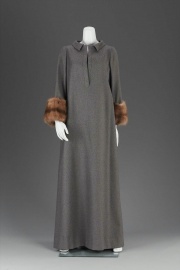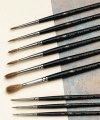Difference between revisions of "Sable"
| Line 4: | Line 4: | ||
Fur and hair obtained from any of three related species: | Fur and hair obtained from any of three related species: | ||
| − | - Russian fitch (''Martes zibellina'': black sable, Russian sable), | + | - [[Fitch hair|Russian fitch]] (''Martes zibellina'': black sable, Russian sable), |
| − | - Kolinsky mink (''Mustela sibirica sibirica'': red sable) | + | - [[Kolinsky|Kolinsky mink]] (''Mustela sibirica sibirica'': red sable) |
- Chinese mink (''Mustela lutreola'') | - Chinese mink (''Mustela lutreola'') | ||
| − | - Chinese weasel (''Mustela sibirica fontaniere''). | + | - [[weasel|Chinese weasel]] (''Mustela sibirica fontaniere''). |
Sable pelts are durable. The brown-black pelts have short, fine fur with silky guard hairs. Sable furs from Siberia have been traded since at least the 11th century. Sable was an expensive fur that was worn by nobles and the aristocracy. Guard hairs from the tail are used in artist brushes. Artist brushes prepared with red sable are considered superior to those made with black sable. The black sable brushes are less resilient, shorter, and stiffer than kolinsky (red sable) brushes. | Sable pelts are durable. The brown-black pelts have short, fine fur with silky guard hairs. Sable furs from Siberia have been traded since at least the 11th century. Sable was an expensive fur that was worn by nobles and the aristocracy. Guard hairs from the tail are used in artist brushes. Artist brushes prepared with red sable are considered superior to those made with black sable. The black sable brushes are less resilient, shorter, and stiffer than kolinsky (red sable) brushes. | ||
Revision as of 11:57, 18 October 2020
Description
Fur and hair obtained from any of three related species:
- Russian fitch (Martes zibellina: black sable, Russian sable),
- Kolinsky mink (Mustela sibirica sibirica: red sable)
- Chinese mink (Mustela lutreola)
- Chinese weasel (Mustela sibirica fontaniere).
Sable pelts are durable. The brown-black pelts have short, fine fur with silky guard hairs. Sable furs from Siberia have been traded since at least the 11th century. Sable was an expensive fur that was worn by nobles and the aristocracy. Guard hairs from the tail are used in artist brushes. Artist brushes prepared with red sable are considered superior to those made with black sable. The black sable brushes are less resilient, shorter, and stiffer than kolinsky (red sable) brushes.
Synonyms and Related Terms
black sable; red sable; Russian sable; Russian fitch (Martes zibellina); Kolinsky mink (Mustela sibirica sibirica); Chinese weasel (Mustela sibirica fontaniere); Chinese mink (Mustela lutreola); zobel (Dan.); Zobel (Deut.); sabelmarter (Ned.); zibelina (Port.); zibelline (Fr.)
Physical and Chemical Properties
Guard hair is regular with length of 1.5 - 2.5 inches.
Additional Images
Resources and Citations
- Encyclopedia Britannica, http://www.britannica.com Comment: "sable" [Accessed November 15, 2001]. (picture)
- F. Kidd, Brushmaking Materials, Bristish Brush Manufacturers, London, 1957
- Zora Sweet Pinney, 'A Handle on the Terms used for Artists' Brushes', unpublished glossary, 1999
- Ralph Mayer, A Dictionary of Art Terms and Techniques, Harper and Row Publishers, New York, 1969 (also 1945 printing)
- Edward Reich, Carlton J. Siegler, Consumer Goods: How to Know and Use Them, American Book Company, New York City, 1937
- Wikipedia: http://en.wikipedia.org/wiki/Sable (Accessed Sept. 14, 2005)




